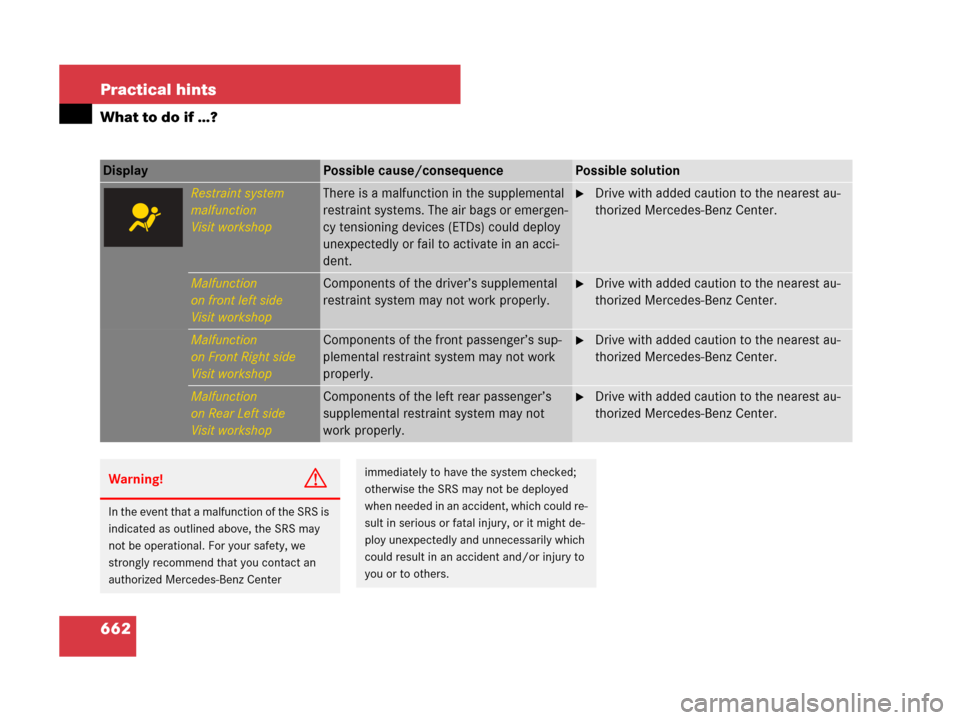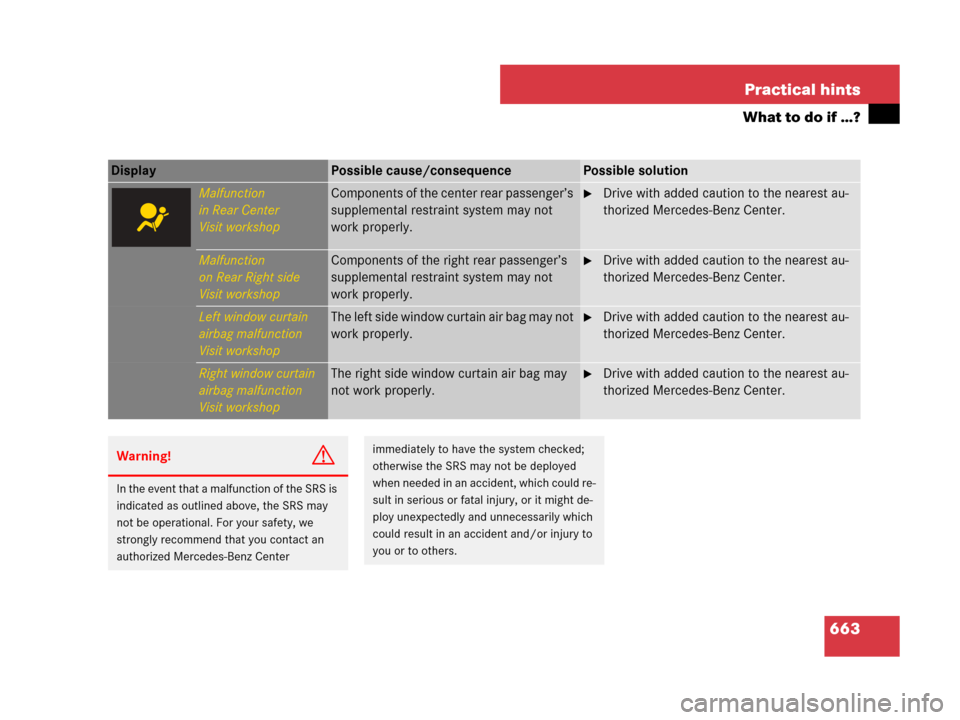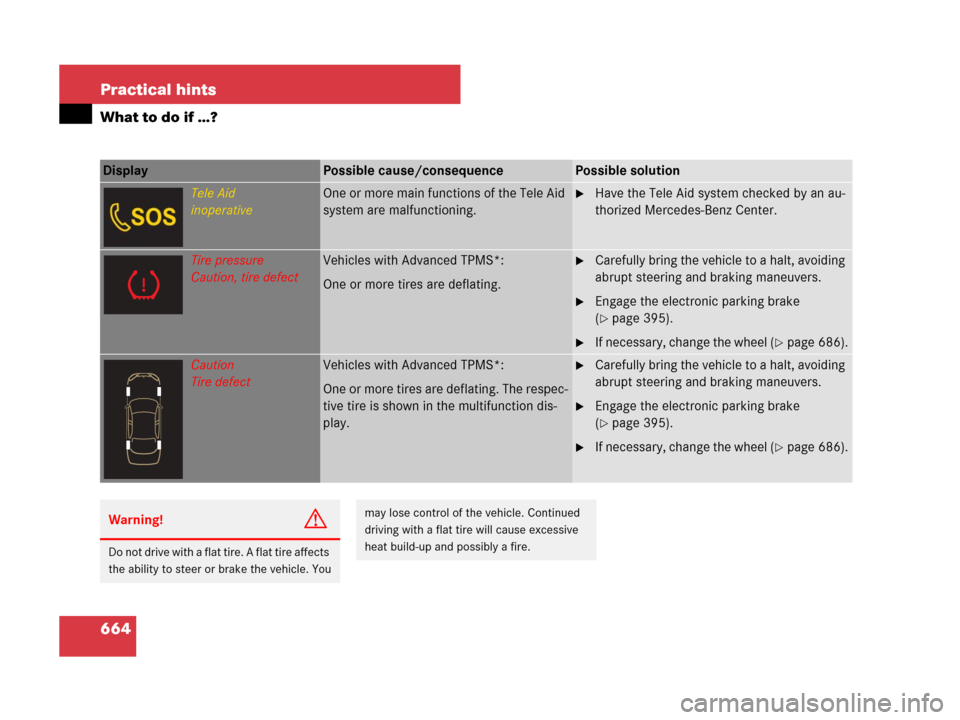Page 662 of 761
661 Practical hints
What to do if …?
Display Possible cause/consequencePossible solution
Engine oil level
cannot be
measuredS 600 and S 65 AMG only:
The measuring system is malfunctioning.�Have the measuring system checked by an
authorized Mercedes-Benz Center.
Engine oil level
Reduce oil levelS 600 and S 65 AMG only:
You have added too much engine oil.
There is a risk of damaging:
�the engine
�the catalytic converter
�Have excess oil siphoned or drained off. Con-
tact an authorized Mercedes-Benz Center.
Page 663 of 761

662 Practical hints
What to do if …?
Display Possible cause/consequencePossible solution
Restraint system
malfunction
Visit workshopThere is a malfunction in the supplemental
restraint systems. The air bags or emergen-
cy tensioning devices (ETDs) could deploy
unexpectedly or fail to activate in an acci-
dent.�Drive with added caution to the nearest au-
thorized Mercedes-Benz Center.
Malfunction
on front left side
Visit workshopComponents of the driver’s supplemental
restraint system may not work properly.�Drive with added caution to the nearest au-
thorized Mercedes-Benz Center.
Malfunction
on Front Right side
Visit workshopComponents of the front passenger’s sup-
plemental restraint system may not work
properly.�Drive with added caution to the nearest au-
thorized Mercedes-Benz Center.
Malfunction
on Rear Left side
Visit workshopComponents of the left rear passenger’s
supplemental restraint system may not
work properly.�Drive with added caution to the nearest au-
thorized Mercedes-Benz Center.
Warning!G
In the event that a malfunction of the SRS is
indicated as outlined above, the SRS may
not be operational. For your safety, we
strongly recommend that you contact an
authorized Mercedes-Benz Center
immediately to have the system checked;
otherwise the SRS may not be deployed
when needed in an accident, which could re-
sult in serious or fatal injury, or it might de-
ploy unexpectedly and unnecessarily which
could result in an accident and/or injury to
you or to others.
Page 664 of 761

663 Practical hints
What to do if …?
Display Possible cause/consequencePossible solution
Malfunction
in Rear Center
Visit workshopComponents of the center rear passenger’s
supplemental restraint system may not
work properly.�Drive with added caution to the nearest au-
thorized Mercedes-Benz Center.
Malfunction
on Rear Right side
Visit workshopComponents of the right rear passenger’s
supplemental restraint system may not
work properly.�Drive with added caution to the nearest au-
thorized Mercedes-Benz Center.
Left window curtain
airbag malfunction
Visit workshopThe left side window curtain air bag may not
work properly.�Drive with added caution to the nearest au-
thorized Mercedes-Benz Center.
Right window curtain
airbag malfunction
Visit workshopThe right side window curtain air bag may
not work properly.�Drive with added caution to the nearest au-
thorized Mercedes-Benz Center.
Warning!G
In the event that a malfunction of the SRS is
indicated as outlined above, the SRS may
not be operational. For your safety, we
strongly recommend that you contact an
authorized Mercedes-Benz Center
immediately to have the system checked;
otherwise the SRS may not be deployed
when needed in an accident, which could re-
sult in serious or fatal injury, or it might de-
ploy unexpectedly and unnecessarily which
could result in an accident and/or injury to
you or to others.
Page 665 of 761

664 Practical hints
What to do if …?
Display Possible cause/consequencePossible solution
Tele Aid
inoperativeOne or more main functions of the Tele Aid
system are malfunctioning.�Have the Tele Aid system checked by an au-
thorized Mercedes-Benz Center.
Tire pressure
Caution, tire defectVehicles with Advanced TPMS*:
One or more tires are deflating.�Carefully bring the vehicle to a halt, avoiding
abrupt steering and braking maneuvers.
�Engage the electronic parking brake
(
�page 395).
�If necessary, change the wheel (�page 686).
Caution
Tire defectVehicles with Advanced TPMS*:
One or more tires are deflating. The respec-
tive tire is shown in the multifunction dis-
play.�Carefully bring the vehicle to a halt, avoiding
abrupt steering and braking maneuvers.
�Engage the electronic parking brake
(
�page 395).
�If necessary, change the wheel (�page 686).
Warning!G
Do not drive with a flat tire. A flat tire affects
the ability to steer or brake the vehicle. You
may lose control of the vehicle. Continued
driving with a flat tire will cause excessive
heat build-up and possibly a fire.
Page 666 of 761

665 Practical hints
What to do if …?
Display Possible cause/consequencePossible solution
Tire pressure
Check tiresVehicles with Advanced TPMS*:
The pressure is too low in one or more tires.�Carefully bring the vehicle to a halt, avoiding
abrupt steering and braking maneuvers.
�Engage the electronic parking brake
(
�page 395).
�Check and adjust tire inflation pressure as
required (
�page 561).
�If necessary, change the wheel (�page 686).
Check tiresVehicles with Advanced TPMS*:
The pressure is too low in one or more tires.
The respective tire is shown in the multi-
function display.�Carefully bring the vehicle to a halt, avoiding
abrupt steering and braking maneuvers.
�Engage the electronic parking brake
(
�page 395).
�Check and adjust tire inflation pressure as
required (
�page 561).
�If necessary, change the wheel (�page 686).
Warning!G
Do not drive with a flat tire. A flat tire affects
the ability to steer or brake the vehicle. You
may lose control of the vehicle. Continued
driving with a flat tire will cause excessive
heat build-up and possibly a fire.
Page 667 of 761
666 Practical hints
What to do if …?
Display Possible cause/consequencePossible solution
Wheel sensor(s)
missingOne or more sensors malfunction (e.g. bat-
tery in one or more wheel sensor is empty).
One or more wheels without wheel sensors
mounted (e.g. spare tire).
No pressure value is shown on the multi-
function display for the tire in question.�Have the Advanced TPMS* checked by an
authorized Mercedes-Benz Center.
�Have the wheel sensors installed by an
authorized Mercedes-Benz Center.
The tire pressure for the respective tire is
shown in the multifunction display after a few
minutes driving.
Tire pressure
Please rectifyVehicles with Advanced TPMS*:
The pressure is too low in one or more tires.
Or the tire pressures of the individual
wheels differ too radically from one anoth-
er.�Check and adjust tire inflation pressure as
required (
�page 561).
Page 668 of 761
667 Practical hints
What to do if …?
Display Possible cause/consequencePossible solution
Shift to 'P'You have attempted to turn off the engine
with the KEYLESS-GO* start/stop button
and opened the driver’s door with the auto-
matic transmission not shift to park
positionP.�Shift the automatic transmission to park
positionP (
�page 399).
or
�Close the driver’s door.
You are driving with the trunk open.�Close the trunk (�page 480).
Washer fluid,
please refillThe water level has dropped to approx.
1.1 US qts (1.0 l).�Add washer fluid (�page 548).
Page 674 of 761

673 Practical hints
Unlocking/locking in an emergency
Mechanically releasing the electronic
parking brake
Depending on vehicle production date your
vehicle may be equipped with a mechani-
cal release device for releasing the elec-
tronic parking brake. It is located behind
the fuel filler flap next to the fuel cap.
1Protective cap
2Release tool
3Pulling
�Shift the automatic transmission to P
(
�page 399).
�Prevent the vehicle from rolling away
by blocking a rear wheel with the wheel
chock. A wheel chock is included with
the vehicle tool kit (
�page 668).
�Open fuel filler flap.
�Remove protective cap1.
�Screw release tool2 from vehicle tool
kit clockwise 2 to 3 rotations onto re-
lease cable.
�Pull release tool2 in direction of
arrow3.
The electronic parking brake is re-
leased. The red indicator lamp0
(USA only) or! (Canada only) flash-
es. The message “Parking brake See
Oper. Manual” appears on the multi-
function display.
�Unscrew release tool2 from release
cable.
�Reattach protective cap1.
�Store release tool2 in vehicle tool kit.
After it has been unlocked, you can engage
the electronic parking brake again from
the driver’s seat.
�Press the electronic parking brake han-
dle (
�page 395).
iIf your vehicle is not equipped a mechanical
release device for releasing the electronic park-
ing brake contact Roadside Assistance or an au-
thorized Mercedes-Benz Center.
Warning!G
If you mechanically release the electronic
parking brake, the vehicle may start to move
on its own. Make sure that no one is in front
of or behind the vehicle. Otherwise, an acci-
dent could occur resulting in injury or fatali-
ty. Before releasing the electronic parking
brake, shift the automatic transmission to P
(
�page 399) and secure your vehicle in
place using the chock from the vehicle tool
kit.
iIf the electronic parking brake is not re-
leased, pull the release tool again with more
force.